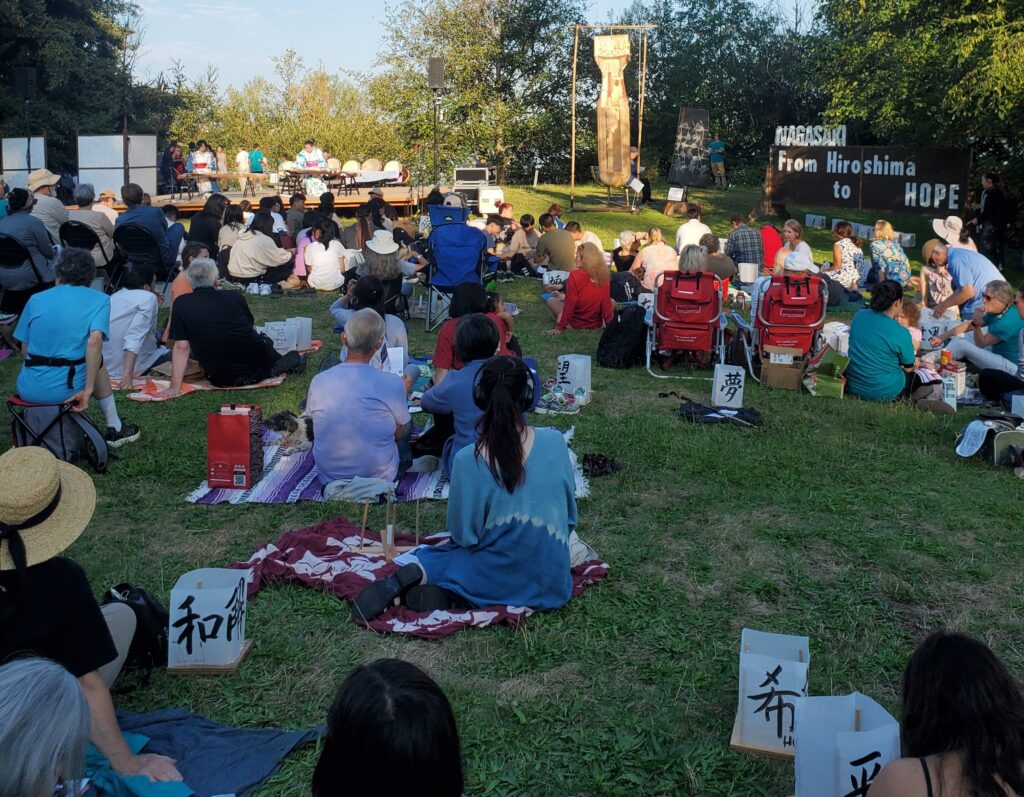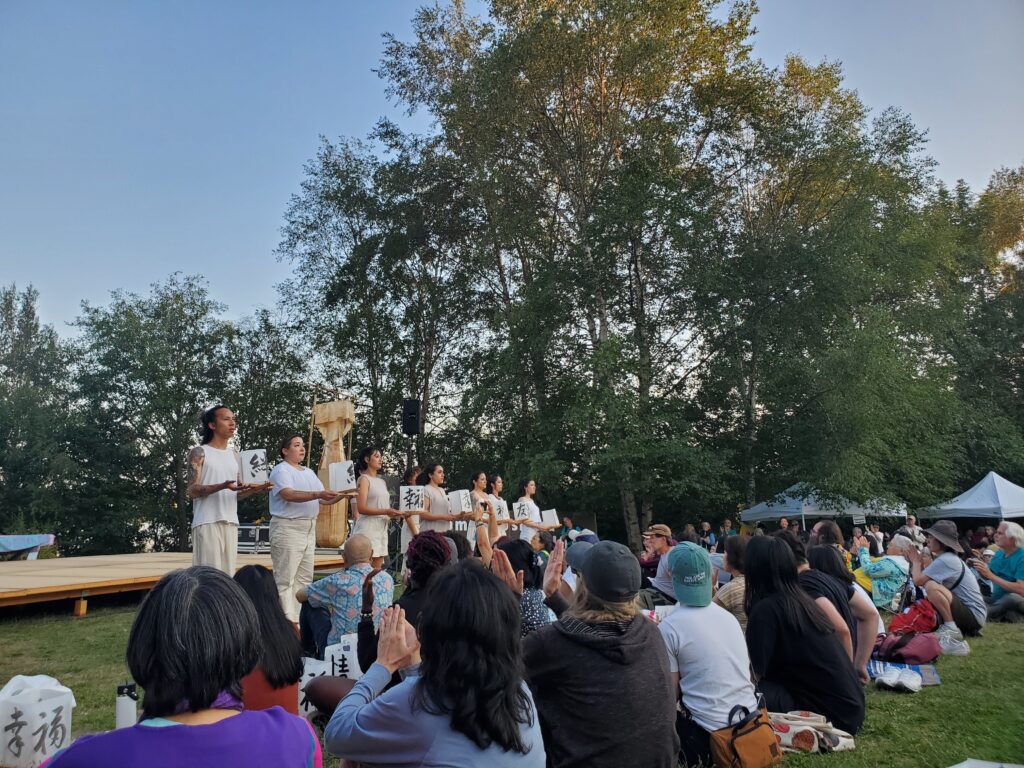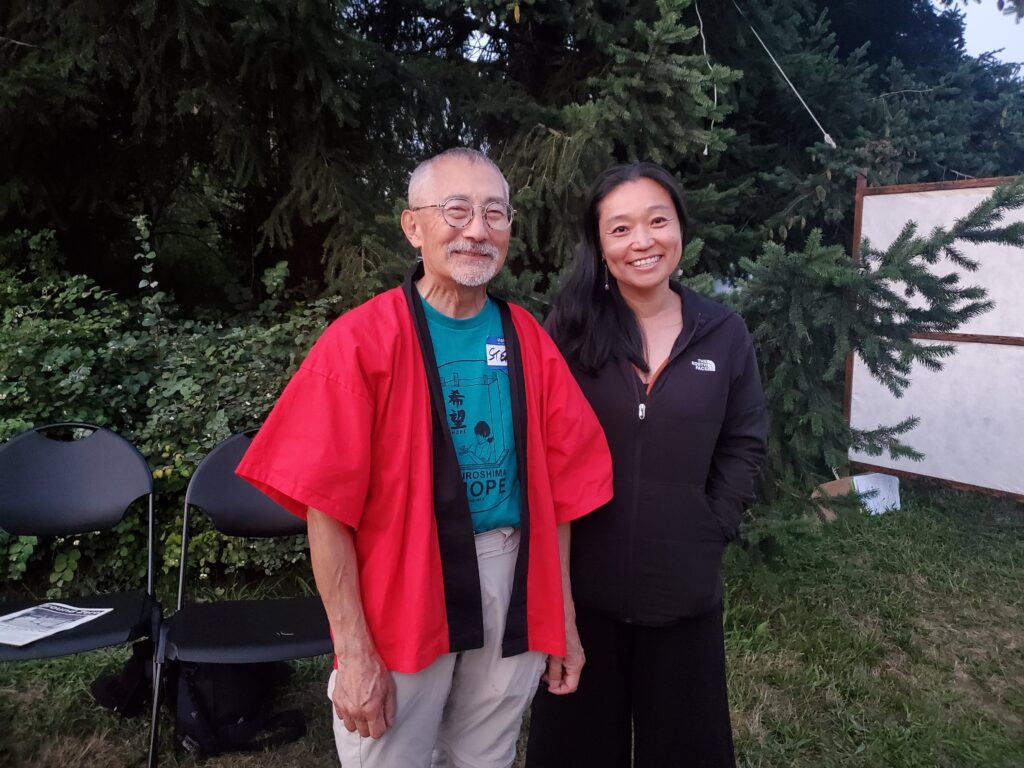August 20, 2024
Earlier this month, we gathered at Seattle’s Green Lake for a solemn and deeply meaningful commemoration of the events of August 6 and 9, 1945, when the cities of Hiroshima and Nagasaki were devastated by atomic bombs. This annual ceremony organized by From Hiroshima to Hope featured powerful art and performance, and culminated in the releasing of dozens of candle-lit lanterns carrying messages of peace, grief, and hope into the lake. In her keynote address — republished here, lightly edited for length and clarity — Densho Executive Director Naomi Ostwald Kawamura reflects on the lessons of Hiroshima and Nagasaki, and our collective responsibility as inheritors of this historical memory.
This ceremony holds a special place in my heart because I am the daughter of an atomic bomb survivor. My father Ikunosuke Kawamura and my grandfather Yoshimi Kawamura survived the atomic bombing of Hiroshima. My grandparents and my father had originally lived in the center of Hiroshima, quite close to the epicenter, but my grandmother contracted tuberculosis during the war and died just two weeks before the bombing. After her death, my grandfather and my father moved within the city to be closer to other family members. Their new home happened to be on the eastside of Hijiyama, a small hill in the center of Hiroshima. While Hijiyama was two kilometers from the epicenter, the hill acted as a small natural shield from the direct blast of the atomic bomb — and so my father survived.
I carry forward this history not only as a daughter and granddaughter of survivors, but as a mother, as an American of Japanese ancestry, and as someone who, through my work at Densho, strives to preserve stories of the WWII incarceration of Japanese Americans by educating the public about this injustice so that it is never repeated. By preserving our history, we not only honor the past but also provide critical lessons for the present and future.

Seventy-nine years ago, the lives of tens of thousands were lost or forever changed. I sometimes find it unimaginable that my father was among those who witnessed the horrors — who survived, and endured the aftermath of that day. While I never lived through this event myself, I was raised by someone who did.
Growing up, I heard stories of resilience, loss, and the struggle to rebuild a life. For my father, the memory of those who were lost and the devastation that followed have remained with him throughout his life. These stories were not just about the past; they were a constant reminder of the fragility of human life and the importance of peace. These stories have also shaped who I am and fuel my commitment to ensuring that the memories of those who suffered are not forgotten. War leaves a long legacy.
Like many survivors, in the past few decades, my father has become very active in sharing his story. I see how so many others are interested in hearing his story — hearing him speak to young people and taking part in oral history projects and panels. He has also since established a floating lantern ceremony in my hometown of San Diego.
I also have begun to see how I am a part of his story. As the daughter of an atomic bomb survivor, it is no coincidence that I have pursued a career in history education and being a good steward of the past. In my role at Densho, the staff and I have the privilege of hearing and preserving stories from Japanese Americans who were incarcerated during WWII. I have seen firsthand how the act of remembering and storytelling can transform communities. I have seen children of survivors hear for the first time the wartime experiences of their father or mother — and how this deeper understanding of their parents can strengthen relationships and foster healing within families. Sharing these stories of the past also provide members of the successive generations a fuller view of the larger story of which they are a part.

The events of WWII are increasingly becoming a part of a distant past. It will be up to members of future generations to ensure this history and the stories of those who survived are not forgotten. Beyond that, the stories of Hiroshima and Nagasaki remind us of the devastating consequences of war, the profound importance of working towards a world free of nuclear weapons, and the ongoing impact of war on the lives of civilians even today.
As we gather to release these lanterns onto the water, we do more than remember or honor the memory of those lost. We are also making a powerful statement about our shared commitment to peace, to understanding, and to reconciliation. Each lantern symbolizes a prayer for peace, a hope for a future where such tragedies are never repeated. They remind us of the fragility of life and the enduring strength of the human spirit.
Peace is not just the absence of war but the presence of justice, compassion, and understanding. It is a commitment we make to one another, to our children, and to future generations. It is a promise to strive for a world where every person can live with dignity and without fear or violence.
These floating lanterns carry with them our collective hopes and dreams. They carry the weight of our memories and the light of our aspirations — a testament to the enduring power of remembrance and our shared desire for a better world while honoring the victims of violence and war.
Collectively, I hope that we are all able to remember the lessons of Hiroshima and Nagasaki, and commit ourselves to building a future where such suffering is a distant memory. As you picture the lanterns drifting across the water, I hope you are able to take a moment to reflect on your own role, and how you might lend your talents, your knowledge, and your resources to actively create a more just and peaceful world. And that you too commit yourself to hope. And together, here in this moment, we honor the past, acknowledge our present, and light the way for the future.

—
By Naomi Ostwald Kawamura, Densho Executive Director
